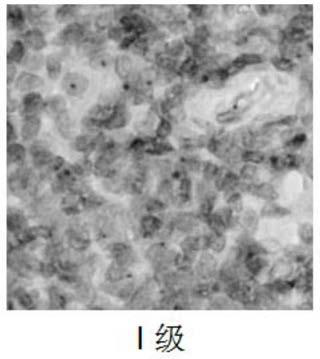Grading model for detecting benign/malignant degrees of lymphoma and lymphatic metastatic cancer and application of grading model
A technology for lymphatic metastasis and lymphoma, applied in the field of gene diagnosis and biology, which can solve the problems of reducing recurrence rate, prolonging survival period, omission, etc.
- Summary
- Abstract
- Description
- Claims
- Application Information
AI Technical Summary
Problems solved by technology
Method used
Image
Examples
Embodiment 1
[0159] Example 1 Imprinted gene analysis of malignant lymphoma
[0160] The detection method of the imprinted gene comprises the following steps:
[0161] (1) Obtain the tissue cell section (10 microns) of malignant lymphoma, put into 10% neutral formalin solution and fix, in case RNA degradation, fixation time is 24 hours, paraffin embedding (FFPE), so The above-mentioned slides need to be detached with positive charges, and the slices are baked in a 40°C oven for more than 3 hours;
[0162] (2) Carry out dewaxing treatment according to the sample processing method of RNASCope to block the endogenous peroxidase activity in the sample, enhance permeability and expose RNA molecules;
[0163] (3) Design probes: design specific primers according to the imprinted gene sequence;
[0164] The design probe is based on imprinted genes Z1 (Gnas), Z4 (Igf2r), Z5 (Mest), Z6 (Plagl1), Z8 (Dcn), Z11 (Grb10), Z13 (Sgce) and Z16 (Snrpn / Snurf) To design, specifically select a sequence in t...
Embodiment 2
[0174] Example 2 Imprinted gene analysis of lymph node biopsy samples from patients with lymphoma
[0175] The lymph node biopsy sample is to take out suspicious lymph node tissue by puncture, fix with 10% neutral formalin solution for more than 24 hours, and other detection methods are the same as in Example 1.
[0176] From Figure 3(a)-Figure 3(f) It can be seen that each gene of Z1, Z4, Z5, Z6, Z8, Z11, Z13, and Z16 is different in its response sensitivity to malignant lymphoma or in other words, the strength and status of the imprint deletion corresponding to the expression of malignant lymphoma are different.
[0177] Specifically, the sensitivity of each imprinted gene to malignant lymphoma is as follows: Figure 4(a)-Figure 4(h) ,From Figure 4(a)-Figure 4(c) It can be seen that the imprinted gene Z1's imprinted deletion, abnormal copy number and increased expression increase rapidly in the malignant potential stage, slow down in the early and middle malignant lympho...
Embodiment 377
[0179] Example 3 Imprinted Gene Analysis of 77 Lymphoma Samples
[0180] Tissues including lymph node biopsy samples were obtained from 77 patients with malignant lymphoma, and the detection method was the same as in Example 1.
[0181] From Figure 5(a)-Figure 5(h) It can be seen that the proportions of imprinted deletions and copy number abnormalities of 8 probes in 77 lymphoma tissue samples showed a distribution from low to high. According to the distribution trends of different probes, we calculated the dotted line in the figure. Grading standard, the imprint deletion, copy number abnormality and total expression of each probe can be divided into 5 grades from low to high.
[0182] The specific classification is as follows:
[0183] It can be seen from Figure 5(a) that for the imprinted gene Z1, any one of the missing expression of the imprinted gene is less than 16%, the abnormal expression of the copy number of the imprinted gene is less than 1.5%, or the total expres...
PUM
 Login to View More
Login to View More Abstract
Description
Claims
Application Information
 Login to View More
Login to View More - R&D
- Intellectual Property
- Life Sciences
- Materials
- Tech Scout
- Unparalleled Data Quality
- Higher Quality Content
- 60% Fewer Hallucinations
Browse by: Latest US Patents, China's latest patents, Technical Efficacy Thesaurus, Application Domain, Technology Topic, Popular Technical Reports.
© 2025 PatSnap. All rights reserved.Legal|Privacy policy|Modern Slavery Act Transparency Statement|Sitemap|About US| Contact US: help@patsnap.com



